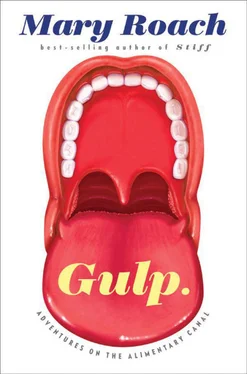It made no difference that neither the specific poisons nor the mechanisms by which they might be causing harm were known or named. In the realm of quackery, vague is better. “It met a need,” wrote Whorton, “that medicine has felt in every age, providing an explanation and diagnosis for all those exasperating patients who insist they are sick, but are unable to present the physician with any clear organic pathology to prove it.” Autointoxication was the gluten of the early 1900s.
Bogus diagnoses beget bogus cures. Around the turn of the last century, hosing the colon was big business, far bigger than it is today, and nowhere bigger than at 134 West Sixty-Fifth Street, home of Tyrrell’s Hygienic Institute, a three-story New York brownstone dedicated to the manufacture and flatulent hyping of the J.B.L. Cascade colonic irrigator. J.B.L. stood for “Joy Beauty Life,” suggesting that your $12.30 was purchasing something loftier than a nozzle-topped whoopee cushion.
“The Internal Bath is taken by sitting on the J.B.L. Cascade,” states Charles Tyrrell in the 1936 promotional pamphlet Why We Should Bathe Internally . Tyrrell’s prior business had been in rubber medical goods. Aside from the rectal nozzle protruding from its flank, the Cascade looked little different from one of Tyrrell’s old water bottles.
Between businesses, Tyrrell had dabbled in small-press publishing. The experience served him well. He printed up thousands of thinly disguised promotional booklets that he distributed to pharmacists to hand out to patients. The gospel of autointoxication and internal putrescence was laid on thick and spiked with testimonials: from customers, doctors, [100] Most of them dead, bought, or similarly corrupt—like the purveyor of Medicine for the Prevention of Motherhood and (perhaps the fallback nostrum) Remedies for Children.
clergy, [101] Judging by the number of testimonials from priests, prelates, sisters, and superiors, religious celibates were avid embracers of rectal irrigation. Inside the J.B.L. Cascade files in the Historical Health Fraud collection of the American Medical Association archives, I found a “Dear Reverend Father” come-on—a special offer “being made to the Catholic Clergy only.” Though Presbyterians found their way to it too; a satisfied Reverend J. H. M. wrote to say that he had “worn out” three bags over the years. Balancing out testimonials from the gentle and the frocked was one by the trainer of the New York Giants from 1930 to 1932, Leonard Knowles. Knowles hinted but did not outright state that the players’ regimen had included sessions with the Joy-Beauty-Life Cascade. In an unusual display of restraint, Charles Tyrrell did not take credit for the Giants’ second- and third-place finishes in the National League during the time Knowles was with the team.
all wordily professing their satisfaction and gratitude. Gone was their insomnia, their fatigue, their melancholia. Here was the fix for acne, bad breath, for lack of appetite and “loss of vim and snap.” An internal bath would rid you of irritability, “outrageous cantankerousness,” “the inability to hold down a job of lumber grading for over six months without quitting or getting fired.” One set of before and after photos seemed to imply that a high colonic could transform an unkempt, drooping moustache into a vigorous, curlicued handlebar.
It seemed there was no medical condition so dire that an internal bath would not fix it. Mr. H. J. Wells of 342 Lincoln Avenue, Detroit, credited the Cascade with relieving his wife of “an accumulation of effete mucous tissue… in strips about half an inch wide and from four to six inches long.” Mrs. Cora Ewing of Long Beach, California, waved good-bye to “a sack of pus above the left ovary.” People thanked Tyrrell for curing their asthma, their rheumatism, their typhoid fever, and their jaundice. Paralysis even! Epilepsy! The medical claims were sufficiently far-fetched that Tyrrell felt a need to point out that the “disorders may be due to factors other than… autointoxication.”
The American Medical Association’s Bureau of Investigation received so many letters from outraged physicians that it drafted a form letter to send in response. “We plan to get around to this institution after a while,” it promised. The first such letter in the Tyrrell Hygienic Institute file at the AMA archives is dated 1894, and the last, 1931, suggesting that a little more vim and snap might have been applied.
One member rose on his own to the task. In 1922, physician and autointoxication doubter Arthur Donaldson artificially and incontrovertibly constipated three dogs by temporarily sewing shut their anus. After four days, all the while eating regular meals of meat, milk, and bread, the dogs showed no physical symptoms beyond a mild loss of appetite—nothing to suggest a poisoning from within. All three, impressively, “seemed to be in fair spirits.”
Donaldson didn’t rest his case there. He withdrew small amounts of blood from his surgically constipated charges, once at the end of fifty-five hours, again at seventy-two hours, and finally at ninety-six hours. This he injected into the bloodstream of two normal, unconstipated dogs, [102] As autointoxication experiments go, this one presents a comparatively minor affront to animal welfare. Less mildly, here is Frenchman Charles Bouchard, in 1893, referring to his laboratory rabbits: “I have practiced intravenous injection with the extracts of fecal matter. It produces depression and diarrhea.” Which begs the question: If you are a caged lab animal under the care of a man who is liable, on any given day, to inject you with human excretions, is it possible to be any more depressed? Ask the animals over in Christian Herter’s lab. Over the course of several months in 1907, Dr. Herter injected rabbits and guinea pigs with fecal extract from lions, tigers, wolves, elephants, camels, goats, buffalo, and horses. Herter wanted to see whether the shit he got from carnivores was more pernicious than the shit he got from herbivores. The rodents died either way, leading one to wonder about the shit he got from the humane society.
to see whether symptoms suggestive of “fecal poisoning” would develop. They did not.
Donaldson contended that the symptoms people and doctors were so quick to blame on autointoxication were in fact caused by the simple mechanics of constipation: rectal distention and irritation. To test the theory, he packed four men with turd-sized wads of cotton. After three hours, the men began to exhibit the sorts of symptoms commonly blamed on autointoxication. The moment the wads were removed, relief ensued. If fecal blood poisoning had been the culprit, relief would have taken far longer. It takes several hours for the liver and kidneys to clear chemicals from the system. The reek of asparagus pee, Walter Alvarez pointed out, though not in those exact words, doesn’t abate the moment you set down your fork. It lingers through the following morning. The very swiftness with which the enema brings relief itself refutes the premise of autointoxication.
In the incomparable phrasings of gastroenterologist Mike Jones, “Everybody who’s bound up feels a whole lot better after a big dump. From where I sit, you don’t need to invoke anything else.”
THE ALTERNATIVE APPROACH to ridding the body of “faeculent poisons” was to eat so much fiber that digesta sped through the colon too quickly to generate them. Insoluble dietary fiber, or roughage, is the indigestible, nonfermentable parts of plants—internal yard trimmings that the gut cannot break down. This fiber sponges up water, contributing dramatically to fecal “bulk.” The bulkier the trash, the sooner you need to empty the bin.
Читать дальше












